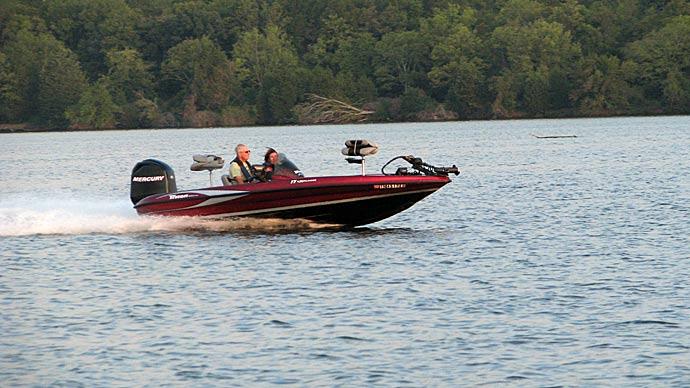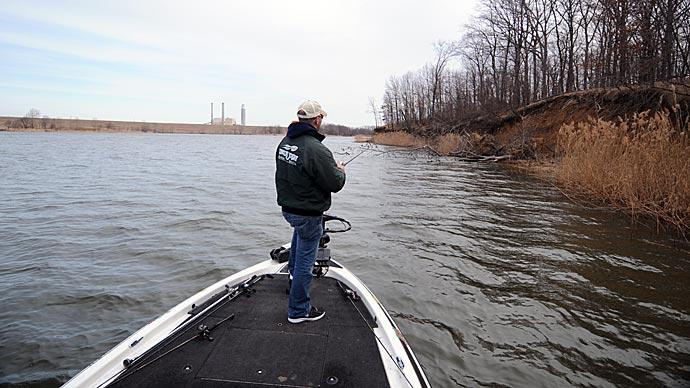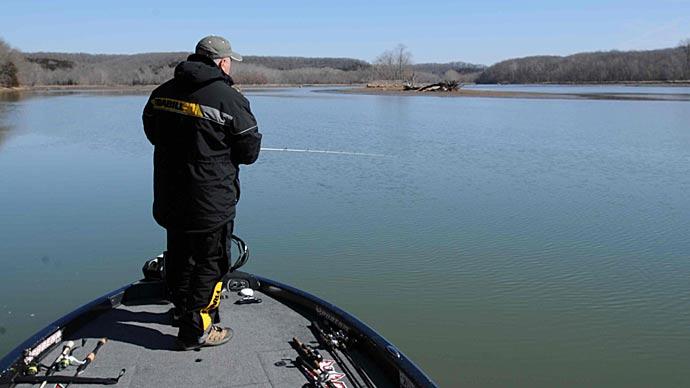
Many folks take our present choices of bass rigs pretty much for granted. However, have you thought about how we arrived at the present selections of sleek, efficient, and increasingly safer boats that specialize in bass fishing?
What do you consider the likely candidate for the first bass boat? Well, you could guess that maybe it was a dugout canoe used for fishing by Indians. Have you ever seen a dugout canoe used by the Caddo Indians of east Texas and western Louisiana? These were often chipped from rather large trees and used for transportation on more extensive waterways. More importantly, if you were a family provider, a bass would not be your number one choice to help you survive. Bass were, at that time, more commonly found in the swampy waterways of the southeastern United States. At the same time, the most abundant types of fish in most streams where people sought food sources were rough fish and the abundant catfish which populated these streams. This trend regarding the type of fish that folks pursued continued until recent times. Those in the 50s to 60s would agree that most of our grandparents referred to fishing with a real emphasis on crappie, catfish, and bream. When that generation went after bass, it was often with large minnows fished in stock tanks or with minimal options for presenting the available forms of artificial baits. Thus, the need for a boat when fishing for bass was a flotation device that allowed you to paddle to more secluded parts of small ponds or less accessible oxbows. Only one large, naturally occurring freshwater lake in Texas was to play an essential part in the development and refinement of the early bass boat.
Taking this further, the development of other manmade lakes gave new options for bass habitat and a greater emphasis for folks to want more unique boats to fish for gamefish in general. Still, many folks were becoming more specialized in fishing selectively for bass. Factor in the tackle and lure industry advance, and you come to the complex offerings for today's bass angler.
One of the places where folks began to take bass fishing seriously and where the swampy environment was ideally suited for the nature of bass was Caddo Lake. My grandfather relayed numerous stories of having a guide split the day on Caddo between bream, crappie, and bass. The Cyprus Jon boat they used drew little water, could with a capable hand, be "sculled" (no trolling motors with up to a jillion pounds of thrust were available back then) into a position where a long line on a stout cane pole could present a "skitter" bait around the cypress stumps. If that did not pan out, big minnows would always be used (sounds a little like Fork in the spring).
One day a fellow, who was a very avid bass fisherman as well as duck hunter, used his experience in both sports to begin to design a boat that would start a new concept by designing a fishing platform that has, through generations of numerous modifications, resulted in the models which we use today. These desired characteristics included stability, shallow draft, and room for carrying desired tackle to allow for easy movement around the inside of the boat. His name was Holmes Thurmond, and he originally came from Shreveport, Louisiana.
In essence, Shreveport is on one side of Caddo Lake (east), and the town of Marshall, Texas, to which he moved, is on the opposite or west side of the lake. He created a 13-foot boat made of wood and constructed it in his garage. The boat had a flanged outside, which gave it excellent stability and resulted in a hull displacement, making it have a very shallow draft. Neighbors soon asked him to build more boats, and one of the first "bass boat" dealers began to market the boat in Shreveport.
All this occurred following his initial boat built in 1948 and extending into the 50s. Overlapping with the development of a unique boat was the development of an electric motor, which permitted more effortless movement of a boat while freeing both hands of the fisherman for the presentation of a lure. This breakthrough was made possible through product development by the MotorGuide Company almost simultaneously as the number of reservoirs began rapidly expanding. Interestingly the boat designed by Mr. Thurman had a pointed nose with just the right amount of deck area at the front to permit the mounting of a trolling motor. Because of its pointed nose, it was dubbed Skeeter.
Almost simultaneously, the Zebco Company introduced the spin cast reel, which allowed anyone to cast efficiently. The use of these reels would have been limited was it not for the advent of quality monofilament line for presenting the ever-expanding choice of bass lures that were entering the market.
The next significant change in the boat after the Stemco Company of Longview bought the drawings and products rights in 1961 was their conversion in 1963 to making the product in fiberglass. This was the most crucial development in bass boat history. Fiberglass products are more easily made in mass production type processes in that molds can be used for reproducibility in form and fabrication. The larger bodies of water dictated that fishermen desired boats to be built in longer dimensions. These larger boats would provide much better and drier rides during fishing outings when anglers encounter rougher water during windy conditions. Also, the larger lakes tempted fishermen with choices that often resulted in them going a considerable distance from their launch site during a fishing trip. The development of a stick-steering designed cable system allowed the driver to steer from the front of the boat and thus have maximum visibility when negotiating through wooded areas.
Suddenly, several companies used the available technologies to construct bass boats. These included Terry Bass and Hustler in Louisiana and two east Texas companies, Kingfisher in Clarksville and Sidewinder in Gladewater. All of the products offered stable fishing platforms for bass fishing, and each had some new added "twitch" to the products. The Dial folks at Clarksville used balsa as hull reinforcement, billed as adding strength and flotation.
This is about the time I came into the avid bass fishing stage as a teenager and knew what the legacy of Sidewinder was from my stump-jumping days running aluminum Jon boats on Lake O'The Pines. I recently fished a tournament on The Pines and can report the same stumps are healthy and just as solid as when I went through sheer pins and props while growing up.
The Sidewinder was made by boat designer A.E. "Pappy" Shipp. His sons, Glenn and John, still run a dealership at the exact location where "Pappy" sold his products. The product, built in 1966, incorporated foam before the government required such safeguards to assure better flotation if the boat swamped. Pappy Shipp loved to fish, and I was told he tried to get several manufacturers to add some features he considered convenient. He included some of these as standards on the Sidewinders, including a compartment under the seat for storage of batteries and a built-in tackle box in the front of the boat.
The evolution of the various hull designs, including semi-V and more pronounced V-designs, began to appear. Many of the smaller manufacturers were challenged to meet the ever-increased regulatory requirements, shifting economic pressures, and the necessity of having ongoing support for additional engineering modifications and chemical specialists to ensure a state-of-the-art product could be produced to meet the increasingly competitive market. This has resulted in many smaller companies either closing or being bought by large conglomerates who invested the capital necessary to stay on the cutting edge of the products.
Given that space-age technology has provided us bass boats that are superior to anything that Mr. Thurmond may have envisioned, the fact is, we still want a stable vehicle out of which to fish - and we want it to incorporate many of the features which lead him to turn his garage into the first bass boat factory.
So having come from the past to the present, it is reasonable to look at some of the present options and share some food for thought as to which of the many bass boats you may want to choose to serve your need best. If Mr. Thurmond were to look at today's rigs, he would be amazed at both horsepower options to power bass boats and the changes from the flat bottoms to the various V-bottoms. But once he got into one of these new boats, a priority would still not be when it was moving, but how "it fished" (sorry, but we still catch fish while going less than five miles per hour).
The same characteristics would be recognized in the boat of today - namely shallow draft, maneuverability, and stability.
The options for today's bass boats can be considered in two flavors: fiberglass or aluminum. To get some basic questions about these two types of boats answered, I decided to talk to folks on the front line of meeting the consumer's needs. I selected a couple of dealers who had from 20- to 40 years in the bass boat business. Each sold aluminum and fiberglass boats and together represented the major lines of bass boats in the past or present. The questions were evident such as the advantages or disadvantages of glass compared to aluminum. Performance differences, public perceptions as indicated by purchasing trends, and where is the future going?
To begin with, everyone was sensitive to the need to encourage young people to enjoy the out of doors and particularly learn how to fish. Of course, the latter point requires someone to teach youngsters how to fish, but that is a different problem.
A consensus among all the dealers was that aluminum boats have become much more competitive in performance, as well as hull and internal design. Of course, the new heavier gauge aluminum used in many of today's bass boats allows the boats to be made larger, thus taking larger engines and providing many of the features of convenience that not long ago was the exclusive territory of the molded glass models. Most earlier aluminum bass boats were Jon boat hulls with built-in compartments. Now, the hulls of aluminum boats offer more significant variations in hull design, which permit smoother rides in rough water and overall performance than their earlier cousins. Even with this engineering advance, you still need the capability to do with aluminum, which you can do with molds to create a fiberglass boat.
There was a split decision about the potential repair for the aluminum hull versus the fiberglass hull. One dealer felt that, in the end, you were more likely to return a fiberglass hull to its original form than a severely damaged aluminum hull. The choice of aluminum bass boats was agreed by all to often come down to an economic issue. You can often appear to get more boat for the dollar with an aluminum rig. The other advantage, one dealer noted, was that people with smaller pickups or towing vehicles would often choose the lighter aluminum rig over the equivalent length glass rig simply because they are lighter and thus easier to pull and stop the trailer carrying such a rig. A number of the aluminum and glass rigs purchased are multi-use rigs. In other words, a surprising number of aluminum boats sold from all dealers were to be used for fishing and hunting (I bet you cannot guess what color most of these were).
The glass rigs continue to offer new hull design technologies and construction materials. Wood is being used less and less in bass boats. Thus the concern of water contact with the resultant damage to wood is rapidly becoming a thing of the past.
The one issue that may be a point worth considering when buying a glass boat, particularly larger boats with larger motors, is how complex it is to control the boat at speeds above 60 miles per hour. Some do not want to go faster than 60 anyway. Still, those who do should test drive any boat they wish to buy to assess the potential for achieving such speeds to see if the rig holds the water or if you are constantly fighting the steering system to avoid "chime walking."
The continual rise in the cost of bass rigs has caused considerable differences in boats equipped with all the bells and whistles versus similar but less expensive rigs. The latter may not have all the radar, depth finders, and various cosmetic niceties, but it still does an excellent job for less. Many of the larger companies are aware of economic issues confronting a consumer. You will see a more competitively priced series of bass boats in the future from these companies. There is a point where the potential market is significantly reduced when manufacturers price themselves into a position where it is difficult for many buyers to afford a new rig.
We have come a long way from the design of a specialized bass boat by Mr. Thurmond. You can have as many colors as the mind can imagine, go at speeds that will get you a ticket on land, and ride dry in rough water. The bottom line is, as with Mr. Thurmond, does it do what you want it to for your style of bass fishing?
I think the best way to know is to ride, and if possible fish, in your proposed purchase before committing to something that might not match your needs.




